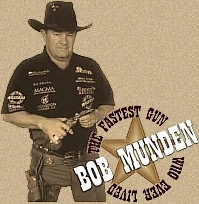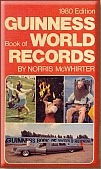

Bob Munden began setting world Fast Draw records while still a teenager, and over his long career accomplished amazing shooting feats for audiences around the world.
Munden was lucky enough to grow up in areas of Southern California where he could become proficient first with a sling shot, then a BB gun, pellet rifle, and archery with a bare bow. Bob said that archery taught him instinctive shooting, which he used to full effect when shooting rifles, shotguns and handguns. He entered his first shooting contest at 11 years old in the desert near Barstow. Bob’s first major Fast-Draw shooting competition was Jeff Cooper’s Old Miner’s Days Leatherslap, using live ammunition, when Bob lived in the San Bernardino mountains and attended Big Bear High School in the community of Big Bear Lake. In the Leatherslap, Bob took second in the revolver class when he was 16.
Munden’s record-setting days began soon after he discovered Fast-Draw competition with blank ammunition. Contests took place in the cities all over Southern California in the 1960s and 1970s. The top shooter at the time was Curtis Blakemore, who had developed a method of Fast Draw superior to the styles everyone else was using. While drawing and firing a level shot with the single action revolver, Blakemore eliminated a lot of motion by drawing the gun while moving the holster away from the gun, and by moving his hips at the same time. The gun finished, not out in front of him but twisted over the top of the holster. The gun, with the draw follow through, ended sideways close to his side. Munden studied the draw, eliminated even more motion and started establishing records. Before the twist draw, competitors reacted to bell and light signal, drawing and firing their guns in the .40s and .50s. A .50 on a fast-draw timer is a half a second. Blakemore, Bob and a few others were shooting in the .30s. A short-while later, Bob was shooting times in the 20s and blistering teens.
It takes strength to draw a gun out of a holster quickly and level it to fire in Fast Draw. A Colt weighs 2 1/4 lbs. Colts were popular in the beginning of the sport before Rugers came along with a lower price. Colts used to cost $125.00 and a Ruger cost $49.95. Colt copies from Italy and Germany had yet to arrive on the scene. Unfortunately for the sport, some competitors removed the steel barrel of the smaller Ruger .22 and replaced it with an aluminum, .45-caliber barrel. They then bored out the cylinder to use .45 LC loads. These steps made for a far lighter single-action revolver and of course rendered the gun unable to withstand shooting a real bullet. The equipment changes among many shooters included making other parts of the gun lighter as well, part of the effort to make shooting easier and supposedly faster. Bob and Becky Munden named the resulting single actions funny guns, comparing them to the funny cars of drag racing that can look like real, showroom-quality vehicles, but are actually lightweight chassis on rails. Munden considered the use of aluminum or other lightweight materials on single-action revolvers as shooting with no honor.
In spite of the huge advantage shooters with funny guns thought they might have, with his Colt, Munden established Fast-Draw records yet to be surpassed. In 1965 Munden shot at a World Fast Draw Association sanctioned tournament held at the Thunderbird Downs Racetrack behind the Thunderbird Hotel and Casino in Las Vegas. It was the Standing Reaction Balloons event. Munden shot a total of 1.26 seconds for 5 separate shots breaking balloons at 8 feet away, .25-.25-.25-.25-.26. At another WFDA sanctioned tournament, the 1966 Arizona State Championships, Munden shot a phenomenal 1.06 total for the same event, 22-21-20-21-22. The World Fast Draw Association was using the new computer timers by then. Those records have since disappeared from the WFDA history.
When Bob Munden was featured on the American Shooter (1995-2001) television show and later on Shooting USA and Shooting USA’s Impossible Shots, he could finally demonstrate all of his shooting skills he had developed over the years beyond Fast Draw. He loved thinking up new exhibition shots. The segment fans comment on the most is when he hit a 14” x 24” steel rectangle target 200 yards away four times in a row using a stock, iron-sight (no scope) .38 caliber Smith & Wesson Model 60, double-action revolver with a 2” barrel. Right up there in terms of fan appreciation is the shot where he opened a safety pin with a bullet fired from one of his 1911 .45 ACP pistols with which he always used full-charge ammunition. The splitting of two playing cards with a bullet split on an axe blade is pretty popular too. Then there is the one where he stuck a knife straight down into a table and then shot the handle, thereby throwing the knife so that it spun in the air and stuck in a board.
Of all the shots over the years that shocked and entertained the production crews, Becky’s has said her favorite may be when without ever practicing, Bob placed a 50-cent piece on edge, and with a .45 LC bullet brushed the edge of the coin just enough so that the coin spun across a board until it slowed and gently fell over. Munden pulled off a lot of new and spectacular shots for television and live audiences across the country. On one segment of American Shooter Bob fired two shots from his Colt .45 and hit two separate 14” x 24” steel targets so quickly that the shots could not be recorded separately on a computer timer.
Bob said the most difficult shot, one he accomplished many times in front of a camera and shown on DVD, is a shot that to his knowledge had never been done before. He threw and split a playing card in two while it was in the air, using a Colt .45 single-action revolver. The first time Bob accomplished this feat was at the 1986 SASS End of Trail World Championships of Cowboy Action Shooting in Coto de Caza, California, using a .45 single action revolver he had never touched before that belonged to EMF’s Boyd Davis.

In 1995, Bob competed in the Bianchi Cup Pistol Tournament (The NRA National Action Shooting Competition) in Columbia, Missouri. Lots of competitors were there, but Bob was the only one using a Colt .45 single action with iron sights. The Bianchi Cup was designed for double-action revolvers and semi-automatic pistols, and the events are timed. Because he was using a single action, he had to cock and fire his gun for every shot. Still, Munden did well enough in the competition to win money. Becky recalls that many spectators stood there with their mouths open as Bob hit target after target with his cowboy gun. Bob did it for the challenge and the fun. Bianchi Tournament officials test-fired Bob’s ammunition with his gun to make sure Bob was shooting the required 120 power-factor minimum, but Bob was using ammo with a power factor above that, at 175. The DVD Bob Munden — The Collector’s Edition includes a bonus feature with footage and Bob’s commentary of Bob competing in that tournament! It is truly fun to watch.

Bob holds 18 unbroken World Records in Fast Draw competition that he set with a real, stock-weight, Colt .45 single-action revolver. Though the World Fast Draw Association erased the records more than once when they changed regulations or timing equipment, Bob set them again, always using a real gun and a real holster, no light-weight funny guns or gimmick holsters. In competition with blanks, some of his records are:

Walk and Draw Level Event: Fastest Time Ever Recorded: .15 hundredths of one second – Arcadia, CA 06/04/1972.
Standing Reaction Balloon Event: Fastest Time Ever Recorded: .16 hundredths of one second – Norwalk, CA 01/21/1973.
Total of Five Separate Shots, Standing Reaction Balloons: 1 and .06 hundredths of one second – Arizona State Championships, 1966.
Self-Start: Fastest Time: .0175 hundredths of one second – Guinness Book of World Records Museum, New York, 1976. This time is less than one half, of one half, of one tenth of one second. Bob is recognized by the Guinness Book as: “Fastest Gun” “Quickest Draw” and “The Fastest Man With A Gun Ever Alive.”

Using live ammunition, Bob holds the record for hitting a 2′ x 4′ steel, rectangle target 21′ away in .21 hundredths of one second.
Bob isn’t the only one in his family who has been listed in the Guinness Book of World Records. In the 1970s’, Becky Munden was listed for her Fast Draw Record of .27 hundredths of one second for Standing Reaction Balloons.

Bob’s brother, CW4 Philip G. Munden, U.S. Army, Aviation (retired), holds 5 world records he set as a member of the U.S. Army’s Golden Knights sky-diving team. Individually, Phil holds a parachuting record for making 43 consecutive, dead-center landings at night on a 10 cm (3.9″) disk.
Bob and Phil’s world records last appeared in the same edition of the Guinness Book in 1980.
If you look at recent editions of the Guinness Book of World Records, you will notice that with the exception of Olympic records, most shooting records are no longer listed, including those set by Annie Oakley, Ed McGivern, Tom Frye and Bob Munden.
A Note From Bob About The Guinness Book of Records
“In 1981, the year most shooting records disappeared from the Guinness Book, I called David Boehm of the Sterling Publishing Company and asked why. He told me that there is a committee that approves books to be used in school libraries across the nation. The committee informed Mr. Boehm that it would only approve the Guinness Book for continued use as a reference book in school libraries if gun records were removed. To protect the Guinness Book from a black list, that’s what the publishing company felt it had to do. If you look at recent editions of the Guinness Book of World Records, you will notice that most gun records by shooters using real firearms (not gimmicked with things like light-weight aluminum barrels,) are no longer listed, including those set by the famous Annie Oakley, Ed McGivern, Tom Frye and myself. It is a shame that a small group of people on that education committee, people who probably grew up in cities away from the shooting sports millions of Americans and citizens of many other nations appreciate and enjoy, can have the power to effectively erase history.”
— Bob Munden
